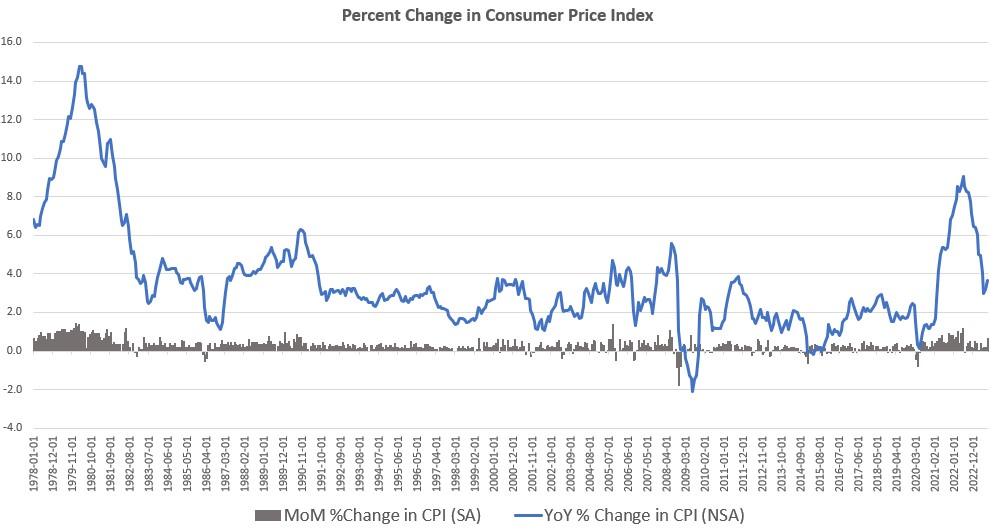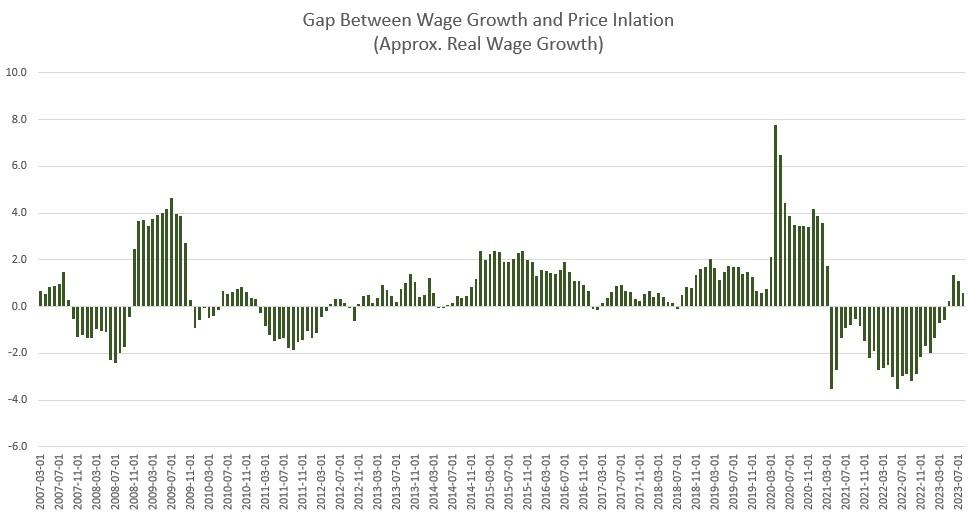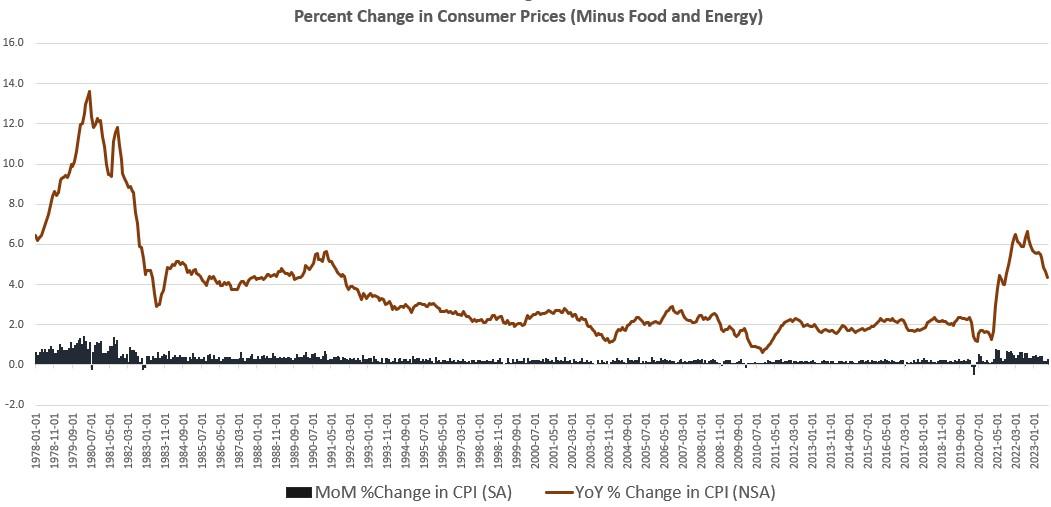The federal government’s Bureau of Labor Statistics (BLS) released new price inflation data last week, and according to the report, price inflation during August accelerated, coming in at the highest year-over-year increase in three months. According to the BLS, Consumer Price Index (CPI) inflation rose 3.7 percent, year over year, in August before seasonal adjustment. That’s up from July’s year-over-year increase of 3.2 percent, and August is the twenty-ninth month in a row with CPI inflation above the Fed’s arbitrary two-percent inflation target. (More precisely, the Fed targets a two-percent rate in the core PCE measure. In August, the year-over-year change in the core PCE was double the target at 4.2 percent.)
Meanwhile, month-over-month CPI inflation rose 0.6 percent (seasonally adjusted) from July to August. That's the highest month-over-month change in 16 months. August’s year-over-year growth rate is down from last August 2022's year-over-year growth rate of 8.3 percent.
(This all assumes federal CPI numbers are reliable and accurate. For more on how these numbers are of dubious reliability in practice, see Jonthan Newman's article from last week: "Current CPI Inflation is Worse than Reported.")
August's acceleration in inflation rates may suggest that recent predictions of price inflation being "over" are premature. The narrative that price inflation has already melted away has never been accurate, of course. Price inflation has hardly vanished, it has only slowed. Moreover, after months of near 40-year highs in price inflation during most of 2022, a mere slowing of inflation does nothing to reverse the growing cost-of-living issues that many American consumers continue to face.
August's growing price inflation reflects continued growth in prices for food, medical care, shelter, Food prices in August were up by 4.3 percent, year over year. Medical care commodities were up 4.5 percent during the same period. Services-minus-energy-services were up 5.9 percent, year over year. Prices in energy overall fell 3.6 percent, year over year, with gasoline prices dropping 3.3 percent over the same period.
Shelter prices have seen some of the most robust growth in recent years, and increases have remained among the highest we’ve seen since the 1980s. During August, however, year-over-year growth in shelter prices slightly slowed as shelter prices increased 7.3 percent in August. That's down from July's year-over-year increase of 7.9 percent, and was the fifth month of slowing increases for shelter prices.
Meanwhile, real wages in August were nearly flat with a year-over-year increase in average hourly earnings of approximately 0.6 percent. August was the fourth month in a row of real wages turning every-so-slightly positive after 25 months of declining real wages. According to new BLS employment data released earlier this month, nominal wages grew with hourly earnings increasing 4.3 percent year over year in August. But with price inflation at 3.7 percent, real wage growth was under one percent.
Moreover, once we look beyond food and energy—the two most volatile components of the CPI—price inflation is still double the official arbitrary target of two-percent price inflation. This so-called "core inflation" rate of increase fell to 4.3 percent in August, but that's not down much from July's growth rate of 4.7 percent, or from the 40-year high of 6.6 percent reached last September. Month-over-month, the CPI increased by 0.3 percent in August (seasonally adjusted). That's the highest month-over-month growth in price inflation in three months, and the first time in six months that the measure has increased month-over-month.
Following the report's release, the media was forced to admit that price inflation isn't melting away the way Wall Street prognosticators and countless pundits insist is the undeniable trend. NBC stated that price inflation "ticked upward." The New York Times concluded "price pressures remains stubborn." Barron's declared rising CPI growth shows "the Fed isn't yet in the clear."
This is all true enough. The last time the US faced a large surge in price inflation—i.e., the 1970s—CPI growth generally slowed from a 1973 peak during 1975 and into 1976. Thanks to continued Fed unwillingness to let interest rates readjust according to market realities, price inflation then surged to even higher levels throughout 1977 and 1978, however.
Nonetheless, many economists, Wall Street Investors, and media pundits used the slight slowing of price inflation during the summer to justify more rate cutting from the Fed. Desperate to boost asset prices with another burst of easy money, Wall Street "elites" and their allies in Washington are demanding cuts in the target policy interest rate.
It is clear, however, that the Federal Reserve still fears the political fall-out from price inflation, as it refused to lower the policy target rate at its FOMC meeting this week. The target rate remains at 5.5 percent.
This isn't to say that 5.5 percent is the "correct" rate. The Fed has no idea what market interest rates would be without constant Fed intervention. Most interest rates would likely be considerably higher than 5.5 percent if left to the marketplace, but the Fed continues to force down rates to keep interest rates on government debt relatively low as the national debt balloons.
In other words, a target rate of 5.5 percent is what is politically expedient for the Fed right now. And that's what Fed policymaking is all about: political expedience. The Fed fears high inflation rates will spiral out of control and cause political instability. So, the Fed knows it has to do something about inflation. But it also can't let the market determine rates because that could finally trigger the inevitable bust that must come after years of an inflation-fueled boom. The Fed knows this must happen sometime, but the Fed also diligently works to avoid this happening in a presidential election year.
So, when we see Fed policy on inflation, we must keep in mind that "managing the economy," as the Fed sees it, is secondary to managing public debt service and public expectations. The takeaway from the acceleration in price inflation last month, coupled with inaction from the Fed, tells us the Fed continues to fear that price inflation is not disappearing fast as the pundits and Wall Street welfare queens would have us believe. On the other hand, the Fed is also hoping that inflation has stabilized enough, for now, to be politically tolerable for the regime.
Full story here Are you the author? Previous post See more for Next postTags: Featured,newsletter
























